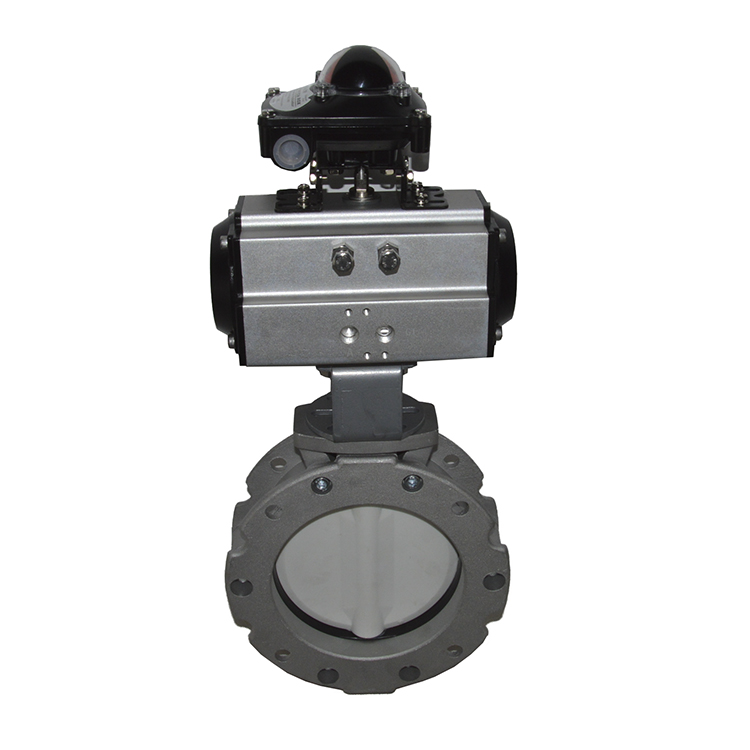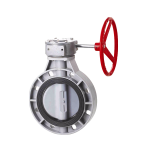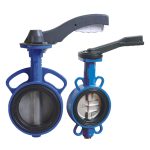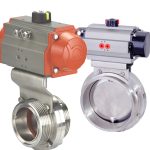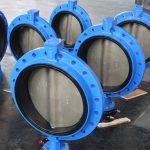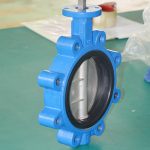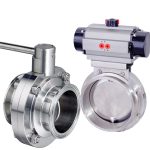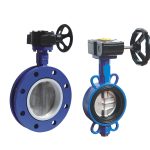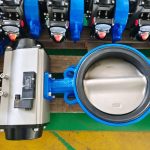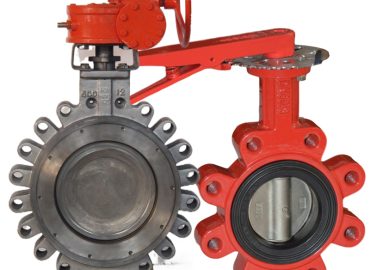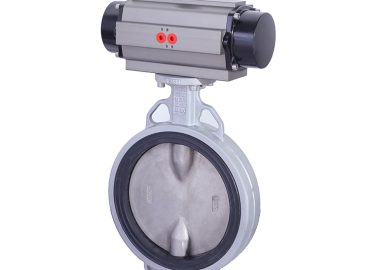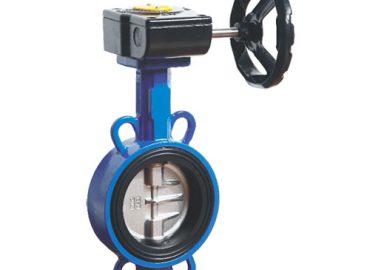Butterfly valve have long been a staple in the chemical industry, playing a crucial role in regulating and isolating the flow of various fluids and gases. Among the different types of butterfly valves available, powder butterfly valves have emerged as an innovative solution that offers numerous advantages in this demanding sector. In this blog post, we will explore the benefits that powder butterfly valves bring to the table, including improved sealing performance, enhanced corrosion resistance, reduced maintenance and downtime, versatility in handling different media, cost-effectiveness, and environmental sustainability. Understanding these advantages can help chemical processing facilities make informed decisions about the equipment they choose, ultimately contributing to safer and more efficient operations.
Introduction
In the chemical industry, where the regulation and isolation of various fluids and gases are paramount, powder butterfly valves have emerged as a game-changing solution that offers numerous advantages. These innovative valves boast improved sealing performance, ensuring that leaks are minimized and safety is maintained throughout the chemical processes. Their enhanced corrosion resistance, derived from the materials used in their construction, protects equipment and lowers maintenance costs in an industry where corrosion can be detrimental. Additionally, the low-maintenance nature of powder butterfly valves results in decreased downtime and increased efficiency, allowing for smoother operations and higher productivity. The versatility of these valves is another significant benefit, as they can handle a wide range of media, including powders, granules, liquids, and gases, making them ideal for diverse applications within the chemical industry. Furthermore, powder butterfly valves are cost-effective and durable, offering long-lasting performance that contributes to overall cost savings. Lastly, their ability to reduce emissions and waste demonstrates their commitment to environmental sustainability – a critical aspect of modern chemical processes. In summary, powder butterfly valves provide a multitude of benefits that make them an invaluable addition to chemical processing facilities, enhancing safety, efficiency, and sustainability.
Brief explanation of butterfly valves and their purpose in the chemical industry
Butterfly valves are a type of flow control device widely used in the chemical industry for their ability to regulate and isolate the flow of various fluids and gases effectively. These valves consist of a circular disc mounted on a rotating shaft, which can be turned to open or close the flow path. When the disc is parallel to the flow, the valve is fully open, allowing unrestricted flow; when it is perpendicular, the valve is closed, stopping the flow completely. The simple yet efficient design of butterfly valves makes them ideal for various applications within the chemical industry, including controlling the flow of corrosive and abrasive materials, managing high-pressure systems, and ensuring safety during chemical reactions. Their compact size, ease of operation, and cost-effectiveness further contribute to their widespread adoption in this sector, making them an indispensable component of chemical processing facilities.
Introduction to powder butterfly valves as a specific type of valve
Silo Butterfly Valve are a specialized type of butterfly valve specifically designed to handle the unique challenges associated with controlling the flow of powders, granules, and other dry bulk materials in various industries, including the chemical sector. These valves feature a modified disc and seal design that significantly improves their sealing performance, ensuring proper closure and preventing leaks even when dealing with fine powders. Additionally, powder butterfly valves are typically constructed from materials that offer enhanced corrosion resistance, making them suitable for handling a wide range of media, such as abrasive and corrosive chemicals. Their robust design and innovative features enable them to outperform traditional butterfly valves in terms of sealing, versatility, and durability, making them an ideal choice for facilities that require precise control over the flow of dry bulk materials and other challenging substances.
Overview of the advantages of using powder butterfly valves in the chemical industry
The use of powder butterfly valves in the chemical industry offers a multitude of advantages that address the unique challenges and requirements of this demanding sector. These valves provide improved sealing performance, ensuring proper closure and preventing leaks when dealing with fine powders and other challenging media. Their enhanced corrosion resistance allows them to handle a wide range of abrasive and corrosive chemicals without compromising on durability or longevity. The low-maintenance nature of powder butterfly valves contributes to decreased downtime and increased efficiency, which are critical factors in a highly competitive industry. Additionally, their versatility in handling different media types, including powders, granules, liquids, and gases, makes them suitable for a diverse range of applications within the chemical industry. Furthermore, the cost-effectiveness and long-lasting performance of these valves lead to overall cost savings, making them an attractive investment for chemical processing facilities. Finally, the environmental benefits associated with reduced emissions and waste showcase their commitment to sustainability, aligning with the growing emphasis on greener chemical processes. In summary, the adoption of powder butterfly valves in the chemical industry offers numerous advantages that enhance safety, efficiency, and sustainability, making them a valuable addition to any chemical processing facility.

Improved Sealing Performance
One of the most notable advantages of powder butterfly valves is their improved sealing performance, which sets them apart from traditional butterfly valves in demanding applications. This enhanced sealing capability is achieved through a combination of innovative disc and seal designs, as well as the use of high-quality materials that ensure a tight closure even when dealing with fine powders and other challenging media. In the chemical industry, where the containment of hazardous substances and prevention of leaks are of utmost importance, the superior sealing performance of powder butterfly valves plays a crucial role in maintaining safety and minimizing the risk of accidents. Moreover, this improved sealing also contributes to increased process efficiency by preventing the loss of valuable materials during transport or processing, leading to cost savings and reduced waste. In addition, the reliable sealing performance of these valves enables them to maintain consistent flow rates and pressure levels, ensuring that chemical processes run smoothly and predictably. Overall, the enhanced sealing performance of powder butterfly valves offers significant benefits in terms of safety, efficiency, and process control, making them an ideal choice for chemical processing facilities that require precise and dependable flow regulation.
Explanation of how powder butterfly valves provide better sealing compared to traditional valves
Powder butterfly valves outshine traditional butterfly valves in terms of sealing performance, primarily due to their innovative design and carefully selected materials. These specialized valves feature a modified disc and seal configuration that ensures a more secure and tight closure, even when handling fine powders and other challenging media. In contrast to the flat disc used in conventional butterfly valves, powder butterfly valves often incorporate a contoured or profiled disc that conforms better to the sealing surface, minimizing gaps and reducing the chances of leakage. Additionally, the seals in powder butterfly valves are typically made from high-quality, durable materials such as PTFE or elastomers, which provide excellent resistance to wear, chemicals, and temperature fluctuations. This combination of an optimized disc shape and superior seal materials results in a more reliable and effective sealing performance compared to traditional valves, making powder butterfly valves a preferred choice for applications that demand precise control and containment of various substances, particularly in the chemical industry.
Discussion of the importance of proper sealing in the chemical industry (preventing leaks, maintaining safety)
In the chemical industry, proper sealing is of paramount importance due to the nature of the materials being handled and the potential consequences of leaks or spills. Ensuring a secure and effective seal in valves, such as powder butterfly valves, is crucial for maintaining safety, preventing contamination, and avoiding costly downtime. The containment of hazardous substances, including toxic, flammable, or corrosive chemicals, is vital to protect both workers and the environment from potential harm. A reliable sealing performance in valves helps minimize the risk of accidents, reducing the likelihood of chemical exposure, fires, explosions, or environmental pollution. Furthermore, proper sealing contributes to the overall efficiency of chemical processes by preventing the loss of valuable materials and ensuring consistent flow rates and pressure levels. This enables smooth and predictable operations, which is essential for maintaining productivity and profitability in this highly competitive sector. In summary, the significance of proper sealing in the chemical industry cannot be overstated, as it plays a critical role in safeguarding people, property, and the environment while supporting efficient and cost-effective operations.
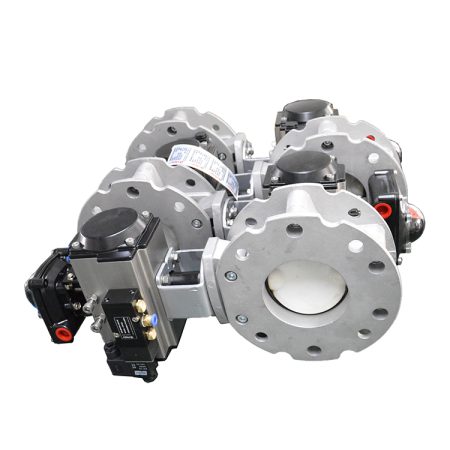
Examples of how improved sealing performance benefits chemical processes
The improved sealing performance offered by powder butterfly valves has a direct and positive impact on various chemical processes, leading to increased safety, efficiency, and cost savings. For instance, in the handling of toxic or volatile substances, the enhanced sealing ensures that these materials are securely contained, minimizing the risk of leaks and potential hazards to workers and the environment. In applications involving abrasive or corrosive chemicals, the superior seal materials and design contribute to the valve’s longevity and resistance to wear, reducing maintenance requirements and associated downtime.
Moreover, the reliable sealing performance of powder butterfly valves helps maintain consistent flow rates and pressure levels throughout the process, ensuring smooth and predictable operations. This is particularly important in reaction-based processes, where precise control over reactant flow is crucial for achieving desired product quality and yield. Additionally, proper sealing prevents the loss of valuable materials during transport or processing, which translates to reduced waste and cost savings for the chemical processing facility.
Lastly, improved sealing performance contributes to environmental sustainability by minimizing emissions and waste generation. This aligns with the growing emphasis on greener practices within the chemical industry and supports compliance with increasingly stringent environmental regulations. Overall, the benefits of enhanced sealing performance in powder butterfly valves are evident across a wide range of chemical processes, making them an indispensable component of modern chemical processing facilities.
Enhanced Corrosion Resistance
Enhanced corrosion resistance is another key advantage of powder butterfly valves, making them particularly suitable for the demanding conditions often encountered in the chemical industry. Corrosion is a common concern in this sector due to the frequent handling of abrasive, corrosive, or chemically reactive substances that can cause degradation and failure of equipment over time. Powder butterfly valves are designed to address this issue by utilizing materials and coatings that offer superior resistance to corrosion and chemical attack. For instance, valve components such as the disc, body, and seals are often made from high-quality stainless steel, PTFE, or other specialized alloys and elastomers that exhibit excellent resistance to a wide range of chemicals and environmental conditions.
This enhanced corrosion resistance not only prolongs the service life of the valve but also contributes to the overall safety and reliability of the chemical process. By minimizing the risk of valve failure due to corrosion, these valves help maintain the integrity of the process and prevent potential accidents, leaks, or spills. Furthermore, the reduced likelihood of corrosion-related maintenance and replacement translates to decreased downtime and lower long-term operating costs for the chemical processing facility.
Additionally, the corrosion-resistant properties of powder butterfly valves enable them to handle a diverse range of media types and applications within the chemical industry, offering greater flexibility and adaptability for facilities with changing process requirements. In summary, the enhanced corrosion resistance of powder butterfly valves plays a crucial role in ensuring the safe, reliable, and cost-effective operation of chemical processes, making them an ideal choice for facilities that handle challenging and corrosive substances.
Description of the materials used in powder butterfly valves that make them more resistant to corrosion
Powder butterfly valves are specifically designed to withstand the harsh conditions of the chemical industry by incorporating materials that offer superior corrosion resistance. These materials are carefully selected based on their ability to resist chemical attack, wear, and degradation, ensuring the valve’s longevity and reliable performance. For instance, the valve body and disc are often made from high-quality stainless steel, such as 316 stainless steel, which is known for its excellent resistance to a wide range of chemicals, high temperatures, and challenging environmental conditions. In addition to stainless steel, other specialized alloys, such as Hastelloy or Monel, may be used in specific applications where even greater resistance to chemical corrosion is required.

The seals in powder butterfly valves are another critical component that contributes to their corrosion resistance. These seals are typically made from durable materials, such as PTFE (polytetrafluoroethylene) or various elastomers, which exhibit outstanding resistance to chemical attack and temperature fluctuations. PTFE, in particular, is highly resistant to most chemicals and solvents, making it an ideal choice for sealing applications in the chemical industry.
Furthermore, powder butterfly valves may also feature additional protective coatings or surface treatments, such as electroplating, passivation, or powder coating, to enhance their corrosion resistance and prolong their service life. These treatments create a barrier between the valve components and the corrosive media, further reducing the potential for chemical attack and degradation. Overall, the use of corrosion-resistant materials and treatments in powder butterfly valves ensures their durability and reliability in the face of the demanding conditions typically found in chemical processing facilities.
Explanation of why corrosion resistance is crucial in the chemical industry (protecting equipment, reducing maintenance costs)
Corrosion resistance is an essential attribute for equipment used in the chemical industry due to the frequent handling of corrosive, abrasive, and chemically reactive substances that can cause damage and degradation over time. Ensuring that components, such as powder butterfly valves, possess high corrosion resistance is critical for several reasons. First and foremost, it protects the equipment from premature failure, which could lead to leaks, spills, or accidents that pose risks to workers, the environment, and the facility itself. By utilizing corrosion-resistant materials and designs, the integrity and reliability of the chemical process are maintained, contributing to the overall safety and efficiency of the operation.
Secondly, corrosion resistance plays a significant role in reducing maintenance costs and downtime associated with equipment repair or replacement. When valve components are resistant to chemical attack, wear, and degradation, they exhibit a longer service life and require less frequent maintenance interventions. This translates to decreased operating costs for the chemical processing facility, as well as reduced production interruptions that could impact productivity and profitability.
Lastly, corrosion resistance contributes to the long-term sustainability of the chemical industry by minimizing waste generation and resource consumption. When equipment remains functional and reliable for extended periods, the need for replacement parts and raw materials is reduced, leading to a smaller environmental footprint. In conclusion, corrosion resistance is a crucial aspect of equipment used in the chemical industry, as it directly affects the safety, efficiency, cost-effectiveness, and sustainability of these operations.
Comparison of powder butterfly valves with other types of valves in terms of corrosion resistance
When comparing powder butterfly valves to other types of valves in terms of corrosion resistance, it becomes evident that powder butterfly valves offer several advantages due to their specialized design and material selection. While traditional valves, such as ball valves, gate valves, or globe valves, may also utilize corrosion-resistant materials like stainless steel or specialized alloys, they often lack the specific optimizations and features found in powder butterfly valves that make them better suited for handling corrosive media in the chemical industry.
For example, powder butterfly valves feature a streamlined design with fewer crevices and dead spaces, reducing the potential for chemical buildup and corrosion. This design simplifies cleaning and maintenance, further contributing to the valve’s longevity and resistance to degradation. Additionally, the seals used in powder butterfly valves are typically made from high-quality materials, such as PTFE or elastomers, which provide excellent resistance to chemical attack and temperature fluctuations. This ensures a more reliable and durable sealing performance when compared to some traditional valve designs.
Furthermore, powder butterfly valves may incorporate additional protective coatings or surface treatments, such as electroplating, passivation, or powder coating, enhancing their corrosion resistance and service life. These treatments are not always found in other valve types, making powder butterfly valves a more robust option for demanding chemical applications.
In conclusion, while other types of valves may also possess corrosion-resistant properties, powder butterfly valves stand out due to their specialized design, material selection, and protective treatments, making them a superior choice for ensuring durability and reliability in the face of the challenging conditions commonly encountered in the chemical industry.

Reduced Maintenance and Downtime
One of the key benefits of using powder butterfly valves in the chemical industry is the significant reduction in maintenance requirements and downtime. This advantage can be attributed to their specialized design, corrosion-resistant materials, and durable sealing performance, which together contribute to the valve’s longevity and reliability. The streamlined design of powder butterfly valves minimizes crevices and dead spaces where chemical buildup and corrosion can occur, simplifying cleaning and maintenance procedures. Furthermore, the use of high-quality materials, such as stainless steel, specialized alloys, and PTFE or elastomer seals, ensures that the valve components are well-equipped to resist chemical attack, wear, and degradation over time.
Reduced maintenance and downtime directly translate to cost savings and increased productivity for chemical processing facilities. By minimizing the frequency of maintenance interventions, facilities can allocate their resources more efficiently, focusing on optimizing production processes and output. Additionally, less downtime due to maintenance or equipment failure means fewer disruptions to the production schedule, which is crucial for maintaining profitability in a highly competitive industry.
Moreover, the reduced need for maintenance and replacement parts contributes to the overall sustainability of the chemical industry by minimizing waste generation and resource consumption. With longer-lasting and more reliable components, the demand for raw materials and energy required for manufacturing new parts is reduced, resulting in a smaller environmental footprint.
In summary, the reduced maintenance and downtime associated with powder butterfly valves play a vital role in enhancing the efficiency, cost-effectiveness, and sustainability of chemical processing facilities. By offering a robust and reliable solution for handling corrosive media, these valves help ensure the smooth and uninterrupted operation of crucial chemical processes.
Discussion of the low-maintenance nature of powder butterfly valves
Powder butterfly valves are known for their low-maintenance nature, which is a highly desirable characteristic in various industries, particularly in the chemical sector. Their unique design and construction contribute to this advantageous quality. The streamlined profile of powder butterfly valves minimizes the presence of crevices and dead spaces where chemical buildup and corrosion might occur, simplifying cleaning procedures and reducing the likelihood of component degradation. Additionally, these valves are typically manufactured using high-quality, corrosion-resistant materials such as stainless steel, specialized alloys, and advanced sealing materials like PTFE or elastomers. These materials not only enhance the valve’s durability in the face of corrosive media but also contribute to its overall longevity and dependability. As a result, powder butterfly valves require less frequent maintenance interventions, saving both time and resources for the facility. This low-maintenance aspect directly translates to reduced operating costs and increased productivity, making powder butterfly valves an attractive option for applications that demand high performance and reliability with minimal downtime.
Explanation of how reduced maintenance leads to decreased downtime and increased efficiency in the chemical industry
In the chemical industry, reduced maintenance plays a pivotal role in decreasing downtime and increasing overall efficiency. The low-maintenance nature of certain equipment, such as powder butterfly valves, directly impacts the frequency of interventions required for upkeep, thereby allowing facilities to allocate resources more effectively. By minimizing maintenance-related disruptions, production processes can run smoothly and continuously, leading to enhanced productivity and output. This uninterrupted operation is crucial for maintaining profitability in a highly competitive sector. Furthermore, the decreased need for maintenance interventions also reduces the time and labor costs associated with upkeep, contributing to more efficient use of resources within the facility. As a result, by investing in low-maintenance equipment, chemical processing plants can optimize their operations and significantly reduce downtime, leading to increased efficiency and cost savings in the long run.
Real-world examples showcasing the impact of reduced downtime on chemical processes
Reduced downtime in chemical processes can have a profound impact on productivity, efficiency, and profitability. In real-world scenarios, facilities that prioritize low-maintenance equipment, such as powder butterfly valves, are able to minimize production disruptions and maintain a consistent level of output. For instance, a chemical plant that produces essential components for the pharmaceutical industry can significantly reduce downtime by implementing low-maintenance valves in their production lines. This uninterrupted operation ensures a steady supply of vital ingredients for drug manufacturing, ultimately benefiting end-users who depend on these medications. Similarly, a petrochemical facility that refines crude oil into various products, such as gasoline, diesel, and jet fuel, can enhance its overall efficiency by minimizing downtime. By utilizing low-maintenance equipment, the facility can optimize its refining process, leading to increased output and reduced costs, which in turn can result in more competitive fuel prices in the market. These real-world examples demonstrate how reduced downtime in chemical processes can provide tangible benefits to both the industry and consumers alike.
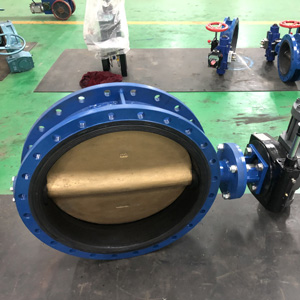
Versatility in Handling Different Media
Versatility in handling different media is a crucial aspect of fluid control systems across various industries, including chemical, pharmaceutical, petrochemical, food and beverage, and water treatment. The ability to manage diverse media types, such as liquids, gases, steam, and even abrasive or corrosive substances, requires specialized valves and equipment that can withstand the unique characteristics of each medium. This versatility is achieved through a combination of factors, including the choice of valve type, proper selection of materials for valve components, and appropriate sealing mechanisms. For example, butterfly valves are known for their adaptability and can handle a wide range of media, from water to aggressive chemicals, by employing different disc materials and resilient seals. Similarly, globe valves offer precise flow control, making them suitable for applications where accurate regulation of flow rate is necessary, regardless of the medium being handled. Material selection is also critical when dealing with corrosive or abrasive media, as it helps ensure the durability and longevity of the equipment. In addition, sophisticated sealing mechanisms, such as Teflon or metal-to-metal seals, are designed to maintain their integrity under high pressures or temperatures. By incorporating these versatile components into fluid control systems, facilities can optimize their operations, reduce maintenance requirements, and enhance overall efficiency, regardless of the specific media being processed. This adaptability ultimately enables industries to meet the growing demands of consumers and remain competitive in a rapidly evolving global market.
Overview of the wide range of media that powder butterfly valves can handle (powders, granules, liquids, gases)
Powder butterfly valves are highly versatile components that are specifically designed to handle a wide range of media, including powders, granules, liquids, and gases. These specialized valves are commonly used in industries such as pharmaceuticals, food processing, chemical manufacturing, and bulk material handling, where the efficient and controlled flow of various media types is critical to the overall process. The unique design of powder butterfly valves, which typically features an inflatable seat or liner, ensures a tight seal and minimizes the risk of product contamination and leakage. This seal is especially important when dealing with fine powders and granules, as it prevents them from escaping into the surrounding environment or clogging the valve’s moving parts. Furthermore, powder butterfly valves can also be effectively used for liquids and gases due to their resilient construction, which allows them to withstand different pressure and temperature conditions. The use of appropriate materials for the valve’s components, such as stainless steel, ensures compatibility with corrosive or abrasive media, while the selection of suitable elastomers for the sealing mechanisms ensures reliable performance in various operating conditions. Additionally, powder butterfly valves provide quick and easy operation, allowing for efficient flow control and reduced downtime. Their compact design also saves space and reduces weight, making them an ideal choice for facilities looking to optimize their processes. In summary, powder butterfly valves offer exceptional versatility in handling a broad range of media, making them indispensable components in numerous industrial applications where effective flow control and sealing are essential.
Explanation of why versatility is important in the chemical industry (handling multiple types of materials)
Versatility is of paramount importance in the chemical industry due to the diverse range of materials and processes involved in various applications. The ability to handle multiple types of materials, including corrosive, flammable, toxic, and reactive substances, is crucial for maintaining efficient, safe, and cost-effective operations. Versatile equipment, such as valves, pumps, and reactors, can be adapted to different process conditions, media types, and temperature or pressure requirements, allowing chemical plants to seamlessly switch between different production lines or accommodate new products without the need for significant modifications or investments. This flexibility not only optimizes resource utilization but also enables chemical companies to respond swiftly to changes in market demand, regulatory requirements, or technological advancements. Moreover, versatility in handling various materials helps ensure the safety of personnel and the environment by minimizing the risk of leaks, spills, or accidents resulting from incompatible equipment or materials. In summary, versatility in material handling is a vital factor in the chemical industry, as it contributes to operational efficiency, cost savings, adaptability, and safety, ultimately enhancing the competitiveness and sustainability of chemical companies in a dynamic global market.
Examples of specific applications where powder butterfly valves are advantageous due to their versatility
Powder butterfly valves are advantageous in a variety of applications due to their versatility, offering precise control and effective handling of dry, free-flowing, and abrasive materials. In the food processing industry, these valves are used to regulate the flow of powdered ingredients, such as flour, sugar, or spices, ensuring accurate dosing and mixing while maintaining hygiene standards. In the pharmaceutical sector, powder butterfly valves play a critical role in controlling the flow of active pharmaceutical ingredients (APIs) and excipients during drug manufacturing, contributing to consistent product quality and compliance with stringent regulatory requirements. The cement industry also benefits from powder butterfly valves’ ability to handle abrasive materials, such as cement powder, fly ash, or limestone, minimizing wear and tear on equipment and facilitating efficient transport and storage operations. In the chemical processing industry, these valves are employed to manage the flow of various powdered chemicals, such as catalysts, pigments, and additives, enabling accurate formulations and safe handling of potentially hazardous substances. Overall, the versatility of powder butterfly valves allows them to be effectively utilized across a diverse range of industries and applications, providing reliable, durable, and precise control of dry, free-flowing, or abrasive materials.
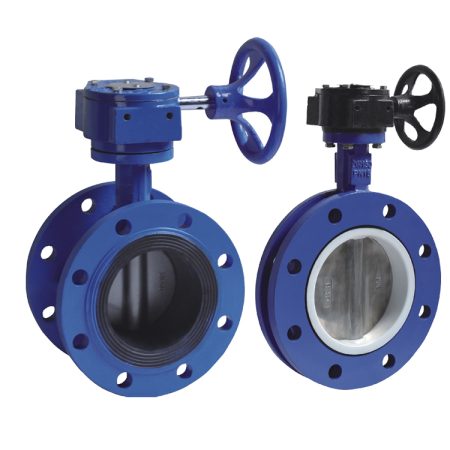
Cost-effectiveness and Longevity
Cost-effectiveness and longevity are essential factors to consider when selecting equipment and materials for various industries and applications. Investing in high-quality, durable products can significantly reduce long-term operational costs by minimizing the need for frequent repairs, replacements, and unscheduled downtime. This, in turn, contributes to enhanced productivity and profitability. Moreover, well-designed equipment that incorporates advanced technologies and materials can lead to increased efficiency, reduced energy consumption, and a smaller environmental footprint, further contributing to cost savings and sustainability.
Longevity is closely linked to cost-effectiveness, as equipment with a longer service life offers a higher return on investment, ensuring that the initial capital outlay is spread over an extended period. To achieve maximum longevity, it is crucial to select equipment and materials that can withstand the specific conditions of the intended application, such as temperature, pressure, and chemical compatibility. Additionally, proper maintenance and servicing of equipment play a vital role in extending its lifespan and maintaining optimal performance. This includes regular inspections, cleaning, lubrication, and timely replacement of worn or damaged components.
In the context of valves, for example, investing in high-quality, versatile, and robust products can result in significant cost savings and longevity. Premium materials, such as stainless steel or corrosion-resistant alloys, ensure that valves can endure harsh operating environments and resist wear and tear. Advanced sealing mechanisms, like elastomers or gaskets, provide tight seals to prevent leaks and maintain system integrity. Furthermore, innovative valve designs can offer improved flow control, reduced pressure drops, and minimized cavitation or turbulence, leading to energy savings and reduced maintenance costs.
In conclusion, prioritizing cost-effectiveness and longevity when selecting equipment and materials can yield substantial benefits in terms of reduced operational expenses, enhanced efficiency, and increased sustainability. By making informed choices and implementing proper maintenance practices, companies can maximize the value of their investments and ensure the long-term success and competitiveness of their operations.
Discussion of the cost benefits of using powder butterfly valves in the chemical industry
In the chemical industry, the use of powder butterfly valves offers notable cost benefits due to their efficient design, durability, and ease of maintenance. These valves are specifically designed to handle dry, free-flowing, and abrasive materials, making them an ideal choice for managing the flow of powdered chemicals, catalysts, and additives. Their streamlined construction minimizes pressure drops, reduces energy consumption, and lowers the risk of clogging or material buildup, resulting in smoother, more efficient processes. The durability of powder butterfly valves, often manufactured from corrosion-resistant materials such as stainless steel, ensures a longer service life, reducing the need for frequent replacements and minimizing unscheduled downtime. This longevity translates into considerable cost savings over time. Additionally, the simplicity of their design allows for easy disassembly and maintenance, further reducing operational expenses associated with labor and replacement parts. In summary, powder butterfly valves provide significant cost benefits in the chemical industry through their efficient performance, robust construction, and low maintenance requirements, making them a valuable addition to various chemical processing applications.
Explanation of how their durability and long-lasting performance contribute to cost savings
Durability and long-lasting performance of equipment, such as valves, play a crucial role in contributing to cost savings across various industries. High-quality, durable equipment requires fewer repairs and replacements over time, which directly translates into reduced operational expenses. By investing in robust, well-constructed equipment, businesses can minimize unscheduled downtime, ensuring that production processes run smoothly and efficiently, thereby maximizing productivity and profitability. Furthermore, durable and long-lasting equipment often exhibits better resistance to wear and tear, corrosion, and other adverse conditions, resulting in lower maintenance costs and a longer service life. This extended lifespan allows companies to spread their initial capital investment over a more extended period, increasing the return on investment and providing a more cost-effective solution. In essence, the durability and long-lasting performance of equipment not only contribute to cost savings through reduced maintenance and replacement expenses but also enable businesses to maintain optimal efficiency, productivity, and competitiveness in today’s fast-paced market.
Comparison of the initial investment and long-term costs of powder butterfly valves with other types of valves
When comparing the initial investment and long-term costs of powder butterfly valves with other types of valves, it’s essential to consider their specific applications, materials, and design features. Powder butterfly valves are designed to handle dry, free-flowing, and abrasive materials, making them well-suited for industries such as food processing, pharmaceuticals, cement, and chemicals. While the initial investment for powder butterfly valves may be higher than some traditional valve types, their specialized design, materials, and sealing mechanisms offer significant advantages in terms of long-term cost savings.
The durability and corrosion resistance of powder butterfly valves, often constructed from stainless steel or other high-quality materials, ensure a longer service life and reduced need for frequent replacements. This longevity contributes to lower long-term operational expenses. Additionally, their streamlined design minimizes pressure drops, reduces energy consumption, and prevents clogging or material buildup, leading to more efficient processes and lower maintenance costs.
In comparison, other types of valves may have a lower initial investment but may not offer the same level of durability, performance, or suitability for handling dry, free-flowing, or abrasive materials. This could result in higher long-term costs due to increased maintenance, repairs, or replacements, as well as potential inefficiencies in the process.
In summary, while the initial investment for powder butterfly valves may be higher than some other valve types, their durability, specialized design, and long-lasting performance can contribute to substantial long-term cost savings. By carefully considering the specific application requirements and weighing the benefits of powder butterfly valves against other valve options, businesses can make informed decisions that maximize efficiency and cost-effectiveness in their operations.
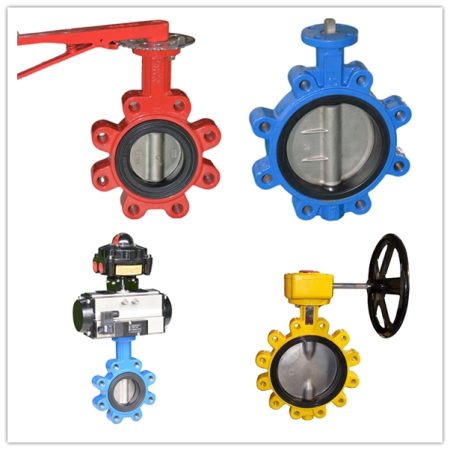
Environmental Benefits
Environmental benefits are increasingly becoming a focal point for businesses, governments, and individuals worldwide as the need to mitigate climate change, reduce pollution, and preserve natural resources becomes more urgent. Implementing eco-friendly practices and utilizing environmentally friendly technologies can lead to significant advantages, both for the planet and for organizations seeking to enhance their sustainability and corporate social responsibility. Among the environmental benefits of adopting such practices and technologies are reduced energy consumption, decreased emissions, minimized waste generation, and efficient use of resources.
In the context of industrial equipment and processes, selecting energy-efficient and durable products can contribute to a smaller environmental footprint. For example, investing in high-quality, long-lasting valves or other process components can result in reduced energy consumption due to minimized pressure drops and optimized flow control. Additionally, durable equipment requires fewer repairs and replacements, leading to a decrease in waste generated from discarded or worn-out components. This also reduces the demand for raw materials and energy required for manufacturing new parts, further contributing to a lower environmental impact.
Moreover, implementing proper waste management practices and recycling initiatives can help companies minimize their waste generation and reduce the amount of material sent to landfills. This not only conserves valuable resources but also reduces the release of harmful greenhouse gases, such as methane, that contribute to climate change. In addition, adopting cleaner production methods and utilizing renewable energy sources, like solar or wind power, can help decrease emissions of CO2 and other pollutants, improving air quality and mitigating the effects of global warming.
Furthermore, the preservation of ecosystems and biodiversity is another crucial aspect of environmental stewardship. By implementing sustainable land use practices, reducing water pollution, and promoting habitat conservation, companies can protect the environment and support the health and wellbeing of local communities and wildlife populations.
In conclusion, the environmental benefits of adopting eco-friendly practices and technologies are manifold, encompassing reduced energy consumption, decreased emissions, minimized waste generation, and the efficient use of resources. By prioritizing sustainability and corporate social responsibility, organizations can not only improve their environmental performance but also enhance their reputation, attract environmentally conscious customers and investors, and ensure long-term business success.
Description of how powder butterfly valves help reduce emissions and waste in the chemical industry
In the chemical industry, powder butterfly valves play a significant role in reducing emissions and waste by providing precise control and efficient handling of dry, free-flowing, and abrasive materials. Their specialized design, featuring tight seals and streamlined construction, minimizes the risk of leaks and fugitive emissions, helping to maintain a cleaner and safer working environment. This also contributes to improved air quality and reduced greenhouse gas emissions, aligning with environmental regulations and sustainability goals. Moreover, powder butterfly valves’ ability to effectively manage the flow of powdered chemicals, catalysts, and additives ensures accurate dosing and mixing, reducing the potential for overuse or spillage of hazardous substances. Consequently, this leads to a decrease in waste generation and resource consumption, further bolstering the industry’s environmental performance. In summary, powder butterfly valves offer valuable benefits in the chemical industry by minimizing emissions and waste, contributing to a more sustainable and eco-friendly operation.
Explanation of the importance of environmental sustainability in the chemical industry
Environmental sustainability in the chemical industry is of paramount importance due to the potential impacts of chemical processes on the environment, public health, and natural resources. Chemical manufacturing often involves the use of hazardous substances, energy-intensive processes, and significant water consumption, which can lead to air, water, and soil pollution if not properly managed. By prioritizing environmental sustainability, the chemical industry can mitigate these risks, reduce its ecological footprint, and contribute to a cleaner, safer world for future generations.
Adopting sustainable practices and technologies, such as energy-efficient equipment, waste reduction initiatives, and cleaner production methods, helps the chemical industry minimize emissions, conserve resources, and reduce costs. This not only improves environmental performance but also enhances the industry’s reputation, making it more attractive to environmentally conscious customers, investors, and regulators. Furthermore, complying with environmental regulations and proactively addressing emerging sustainability challenges can reduce the risk of fines, penalties, or reputational damage associated with non-compliance.
In addition, fostering a culture of innovation and continuous improvement in the chemical industry can lead to the development of greener products and processes that meet the growing demand for sustainable solutions. By investing in research and development, companies can create new materials, applications, and technologies that reduce environmental impacts and contribute to a circular economy.
In conclusion, the importance of environmental sustainability in the chemical industry cannot be overstated, as it directly influences the industry’s ability to protect the environment, comply with regulations, and ensure long-term business success. By embracing environmentally responsible practices and fostering innovation, the chemical industry can play a vital role in driving global progress towards a more sustainable future.
Examples of how powder butterfly valves contribute to greener chemical processes
Powder butterfly valves contribute to greener chemical processes in various ways, primarily through their efficient design, durability, and precise control over the flow of dry, free-flowing, and abrasive materials. First, their streamlined construction minimizes pressure drops and reduces energy consumption, leading to lower greenhouse gas emissions and a smaller carbon footprint. This aligns with the industry’s efforts to adopt more energy-efficient technologies and practices, ultimately promoting environmental sustainability.
Second, the robustness and corrosion resistance of powder butterfly valves, often manufactured from high-quality materials like stainless steel, ensure a longer service life and reduced need for frequent replacements. This longevity results in decreased waste generation from discarded components and less demand for raw materials and energy required for manufacturing new parts. By reducing waste and resource consumption, powder butterfly valves support the goals of a circular economy within the chemical industry.
Lastly, the precise flow control offered by powder butterfly valves ensures accurate dosing and mixing of powdered chemicals, catalysts, and additives. This accuracy minimizes the potential for overuse or spillage of hazardous substances, reducing waste generation and the risk of environmental contamination. Moreover, this precision contributes to more efficient chemical reactions and processes, minimizing the production of unwanted byproducts and further lowering the environmental impact.
In summary, powder butterfly valves play a significant role in promoting greener chemical processes by enhancing energy efficiency, reducing waste and resource consumption, and ensuring precise control of material flow. These benefits not only contribute to improved environmental performance but also support the industry’s broader sustainability goals and efforts to minimize its ecological footprint.
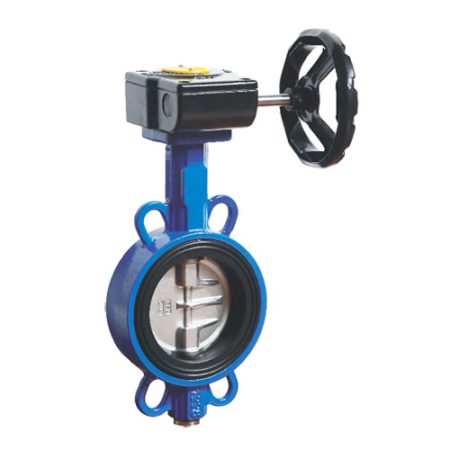
Conclusion
In conclusion, powder pneumatic butterfly valve offer numerous advantages in the chemical industry, making them an essential component for handling dry, free-flowing, and abrasive materials. Their specialized design, durability, and precise flow control capabilities contribute to more efficient, sustainable, and environmentally friendly chemical processes.
One of the primary benefits of powder butterfly valves is their energy efficiency, resulting from their streamlined construction that minimizes pressure drops and reduces energy consumption. This advantage aligns with the industry’s efforts to adopt more energy-efficient technologies and practices, ultimately promoting environmental sustainability and reducing greenhouse gas emissions.
Another key advantage of powder butterfly valves is their durability and long-lasting performance, which can be attributed to the use of high-quality materials like stainless steel. This robustness ensures a longer service life and reduced need for frequent replacements, leading to decreased waste generation from discarded components and less demand for raw materials and energy required for manufacturing new parts. By reducing waste and resource consumption, powder butterfly valves support the goals of a circular economy within the chemical industry.
Moreover, the precise flow control offered by powder butterfly valves ensures accurate dosing and mixing of powdered chemicals, catalysts, and additives. This accuracy minimizes the potential for overuse or spillage of hazardous substances, reducing waste generation and the risk of environmental contamination. Furthermore, this precision contributes to more efficient chemical reactions and processes, minimizing the production of unwanted byproducts and further lowering the environmental impact.
In addition to these benefits, powder butterfly valves also contribute to improved workplace safety and reduced fugitive emissions, thanks to their tight seals and minimized risk of leaks. This helps maintain a cleaner and safer working environment while also complying with environmental regulations and maintaining good air quality.
In summary, the advantages of powder butterfly valves in the chemical industry are manifold, encompassing energy efficiency, durability, waste reduction, precise flow control, and improved safety. By incorporating these specialized valves into their processes, chemical manufacturers can enhance their operational efficiency, contribute to a more sustainable future, and ensure long-term business success. With the growing global emphasis on eco-friendly practices and technologies, the importance of powder butterfly valves in driving greener chemical processes cannot be overstated.
Recap of the advantages of powder butterfly valves in the chemical industry
In recap, powder butterfly valves offer numerous advantages in the chemical industry, playing a vital role in handling dry, free-flowing, and abrasive materials. Their specialized design promotes energy efficiency by minimizing pressure drops, while their durability ensures a longer service life and reduced waste generation. Precise flow control capabilities enable accurate dosing and mixing of powdered chemicals, minimizing waste and environmental contamination risks. Furthermore, their tight seals help maintain a cleaner and safer working environment by reducing fugitive emissions. Overall, these advantages contribute to more efficient, sustainable, and environmentally friendly chemical processes, making powder butterfly valves an essential component in the industry’s pursuit of eco-friendly practices and long-term success.
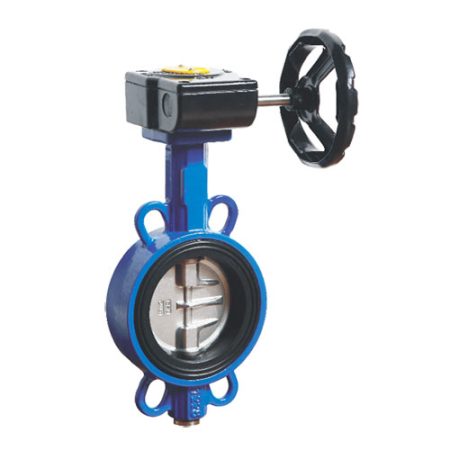
Final thoughts on why powder butterfly valves are a valuable addition to chemical processing facilities
In conclusion, powder butterfly valves are a valuable addition to chemical processing facilities due to their numerous advantages that promote efficiency, sustainability, and environmental responsibility. Their energy-efficient design, durable construction, precise flow control, and ability to reduce fugitive emissions all contribute to more effective and eco-friendly chemical processes. By incorporating powder butterfly valves into their operations, chemical manufacturers can enhance their overall performance while minimizing their environmental impact. Ultimately, the adoption of powder butterfly valves demonstrates a commitment to innovation, sustainability, and responsible practices within the chemical industry, paving the way for a cleaner, greener future in chemical processing and beyond.


